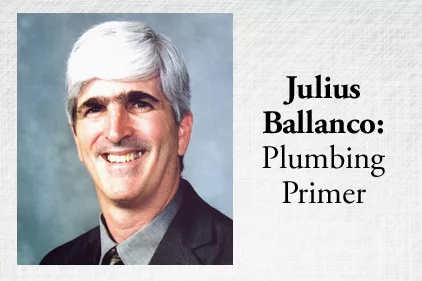Turn food waste into renewable fuel
‘Back to the Future’ energy.


|
| Photo credit: ©istockphoto.com/klikk |
One of my favorite series of movies was “Back to the Future.” I enjoyed watching the skateboarding Marty McFly interact with crazy scientist Dr. Emmett Brown.
You may recall the plot of the first movie centers around Doc being able to get 1.21 gigawatts of power to operate the flux capacitor in order to travel through time. As a technical geek, I realized 1.21 gigawatts equated to 1.21 billion watts. The writers were very clever since many of us learned in science class that lightning releases 1 billion joules of energy. So, equating that to gigawatts didn’t seem too far-fetched, even if time travel was.
At the end of the first movie, Doc Brown comes back to see Marty and warn him about the future. Doc, Marty and Jennifer all take off with the famous ending line of the movie, “Where we’re going, we don’t need roads.”
While everyone was mesmerized by the ending line, I loved the part where, before Doc Brown takes off, he opens the energy module of his DeLorean and starts throwing garbage into the unit. He explained to Marty he was refueling. That seemed rather futuristic. But the question became, “Can you simply turn garbage into energy?”
The movie came out in 1985 but it took until 2014 before turning garbage into energy became routine. We had been talking about it for a long time, but there hadn’t been any tremendous movement to make it commonplace. Now systems are on the market that can take food waste, grind it into a slurry solution and haul the slurry solution to an anaerobic digester to be turned into energy.
It sounds futuristic, but it is real.
From fiction to reality
A little explaining is in order. The word “anaerobic” means absence of oxygen. Digestion is a fancy word for having bacteria convert waste to methane gas and other products, including carbon dioxide. The energy is the methane gas, which we call natural gas when we pipe it into buildings.
The methane can be burned to generate heat or to operate a generator to convert the power to electricity. Hence, the waste becomes a renewable energy.
Anaerobic digestion is not something new within the last 50 years. Italian physicist Alessandro Giuseppe Antonio Anastasio Volta is credited with discovering marsh gas methane in 1776. The first anaerobic digester was built in the 1850s. In the 1890s, attempts were made to turn sewer gas from septic tanks into lamp gas. Even today, many closed landfills are tapped for the natural gas being generated.
The difference is an anaerobic digester is built to specifically generate methane gas. What is left over after the process is completed is fertilizer. Hence, the food waste is converted to natural gas and fertilizer. That is a whole lot better than throwing it into a landfill and hoping one day it will be tapped for natural gas.
The reason we, as a society, have not considered the mass use of anaerobic digesters has to do with cost. It is not inexpensive to build an anaerobic digester; although once built, it does generate energy. The next thing would be to get the waste to be fed into the digester so it can turn the waste into energy.
While the movie shows household food scraps being placed in Doc Brown’s DeLorean, a household amount of food waste is not enough to run a typical anaerobic digester. A digester needs large quantities of food waste. Hence, the systems being installed are at food-handling establishments. Most of you immediately think of restaurants, but add to that every supermarket, butcher shop and food processing plant, to name a few.
New laws are being passed requiring food waste to be diverted away from landfills. The new term is beneficial reuse of food waste. Of course, you can always compost the food waste, but that is rather stinky and messy. The other option is to grind it and send it off to an anaerobic digester.
The logistics
The unit that grinds the food waste for this application is not a food waste disposer but a pulper. However, the actual grinding unit used is the same. Rather than send the food waste down the drain to the sewage treatment plant, the food waste is collected for beneficial reuse.
Pulpers are manufactured by all the major players in the food waste side of the business — InSinkErator, Somat, Hobart, Champion and others. All the pulpers need to have a water supply. However, they use very little water. Again, the system is trying to be green. The typical pulper uses about 2 gal. per min. during the grinding operation.
One manufacturer told me the problem with using water is that water has no energy — a rather funny statement but somewhat true. You cannot get any methane gas out of water. However, water with the food waste does have energy potential. A certain amount of liquid is needed to allow the bacteria to do its thing.
Responding to the water question, some pulpers dewater or dry the food waste. As a result, there is a drainage connection. Other systems take the water used in grinding and add it to the food waste storage. The slurry solution is then pumped out and taken to the digester.
Some of the pulpers are set up to grind the food waste into animal feed. This is another beneficial reuse of food waste.
In many jurisdictions across the country, anaerobic digestion has been taking place for many years at sewage treatment plants. When the local sewage treatment plant has such a digester, the food scraps sent down your food waste disposer are turned into methane and fertilizer. The same is true for the waste that goes down the water closet.
We are “back to the future.” Start making good use of food scraps. Many options are available, so check them out and start turning food waste into energy.
HELPFUL LINKS:
Looking for a reprint of this article?
From high-res PDFs to custom plaques, order your copy today!







